The art of gilding ceramics has a rich history, with numerous traditional pottery villages in our country boasting centuries of experience in producing exquisite gold-plated ceramic items. This craft involves the delicate application of ultra-thin gold leaf, sourced from either industrial gold or authentic 24K gold. To discover more about gold processing on ceramics, read on in the article below, in collaboration with Ceramicsvietnam.com.
What is gold processing on ceramics?
Gold processing on ceramics is a meticulous craft where skilled artisans employ gilding or gold painting techniques to accentuate the texture and form of ceramic pieces. This process results in the creation of luxurious, one-of-a-kind, and artistically intricate products.
The gold plating technique is frequently employed to enhance embossed motifs, while gold painting is often utilized on smooth surfaces or along the contours to delineate product borders.
Understanding the distinct techniques: Gold-inlaid, Gold-drawing, and Gold-gilding in ceramics
Within the intricate world of ceramics, the infusion of gold offers an enchanting dimension. Gold processing on ceramics encompasses a spectrum of techniques, each possessing its own unique characteristics that contribute to the overall allure of these artistic creations. In this comprehensive exploration, we delve deep into the nuances that distinguish gold-inlaid, gold-drawing, and gold-gilding methods, providing a detailed understanding of their applications and intricacies.
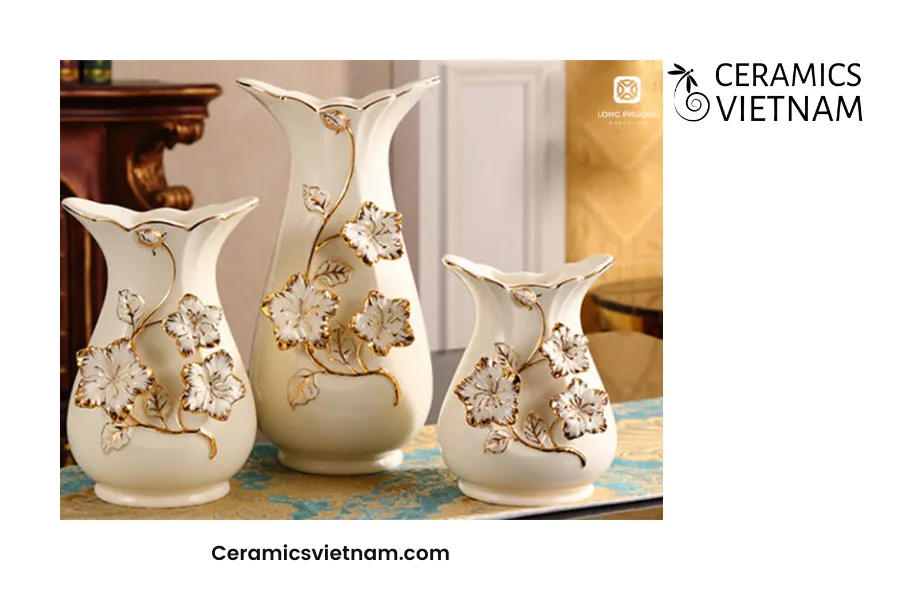
Understanding the distinct techniques_ Gold-inlaid, Gold-drawing, and Gold-gilding in ceramics
Gold-inlaid: The gilded elegance
Gold-inlaid ceramics epitomize the pinnacle of gilded opulence. This technique involves the meticulous application of laminated gold foil to the surface of ceramic objects. It’s a process that demands precision and care, as each piece of gold foil is placed with deliberate intention. The result is a ceramic piece adorned with a regal, tall, and resplendent appearance, emanating an aura of timeless elegance. The longevity of gold-inlaid ceramics is approximately 20 years, subject to factors such as storage and usage conditions. Collectors and connoisseurs hold these pieces in high regard, recognizing their unique beauty and historical significance.
Gold-drawing: The artistry of contours
Gold-drawing, in contrast, is an artistry of precision. This technique is employed to accentuate the contours and textures found on the surface of ceramic creations. It necessitates the steady hand of a skilled artist who meticulously paints along these contours, enhancing the subtle details of the piece. Following the completion of the drawing, the ceramic is subjected to another firing process to ensure the secure adhesion of the gold layer to the ceramic glaze. Gold-drawing achieves a medium level of gold application, striking a harmonious balance between elegance and artistic precision. The longevity of gold-drawing ceramics can extend to nearly 30-40 years, contingent upon how they are stored and used. These ceramics serve as a testament to the fusion of art and craftsmanship.
Gold-gilding: The alchemy of metal and gold
Gold-gilding transcends the boundaries of ceramic adornment by integrating gold with metal. This intricate process involves the inlaying of a thin layer of gold onto the surface of materials such as copper or silver. Gold-gilding can be achieved through chemical or electrochemical methods, resulting in a medium-level gold application akin to gold-drawing. What sets gold-gilding apart is its remarkable resistance to oxidation and corrosion, owing to the integration of metal. This characteristic ensures that gold-gilded ceramics endure the test of time, representing a harmonious union of the radiant beauty of gold and the enduring strength of metal.
A myriad of methods in ceramics artistry
Within the diverse landscape of ceramic artistry, a myriad of techniques exists for inlaid porcelain and drawing porcelain. Each method imparts a distinctive character to the final creation, catering to a spectrum of artistic sensibilities. Whether it’s the opulence of gold-inlaid ceramics, the precision of gold-drawing, or the enduring beauty of gold-gilding, these techniques contribute to the rich tapestry of ceramic art. Artists and collectors alike are drawn to these methods, each appreciating the unique qualities they bring to the world of ceramics.
In conclusion, the art of processing gold on ceramics transcends the mere realm of ornamentation; it elevates ceramics to a pinnacle of unparalleled beauty and craftsmanship. These techniques—be it gold-inlaid, gold-drawing, or gold-gilding—each possess their own distinct charm, contributing to the fascination and appreciation of ceramics within the world of art.
Evaluating the pros and cons of gold-drawing and gold-inlaid ceramics
When it comes to enhancing ceramics with the splendor of gold, two prominent techniques stand out: gold-drawing and gold-inlaid. Each method carries its distinct advantages and disadvantages, shaping the final outcome of these exquisite art pieces. In this detailed analysis, we’ll explore the pros and cons of both gold-drawing and gold-inlaid ceramics, offering a comprehensive understanding of their attributes.
Gold-inlaid ceramics
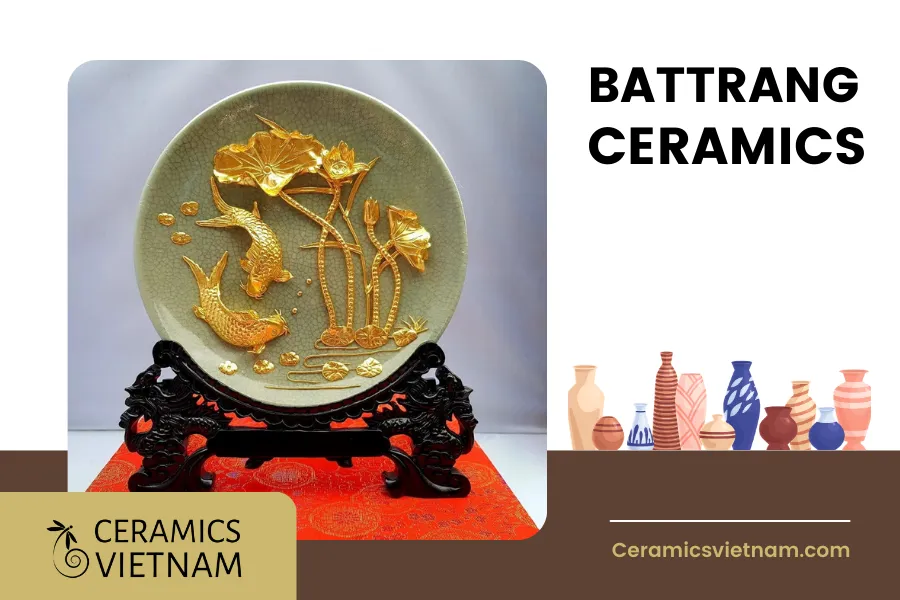
Gold-inlaid ceramics
Gold-inlaid ceramics, a cherished tradition in the world of artistic craftsmanship, exude a sense of opulence and sophistication that few other techniques can match. This time-honored method transforms porcelain into shining masterpieces that not only captivate the eye but also hold cultural and symbolic significance. In this comprehensive examination, we delve into the world of gold-inlaid ceramics, unraveling their inherent advantages and potential drawbacks.
Advantages of Gold-Inlaid Ceramics
- Radiant aesthetics: Gold-inlaid ceramics are renowned for their ability to enhance the surface of porcelain, endowing it with an exquisite shine and an air of luxuriousness. The infusion of gold elevates these pieces to a level of unparalleled elegance and beauty, making them highly coveted in both art and decor.
- Feng Shui elements: Beyond their visual appeal, gold-inlaid ceramics are believed to introduce feng shui elements into spaces. In many cultures, these pieces are associated with attracting luck and good fortune. As such, they hold a special place in homes and environments where harmony and positive energy are valued.
- Versatile motif selection: Gold inlaid ceramics offer unparalleled flexibility when it comes to design. Craftsmen can apply an array of motifs, ranging from intricate and small to bold and large. This unique flexibility sets gold-inlaid ceramics apart from many other manufacturing methods, allowing for a wide range of artistic expression.
Drawbacks of gold-inlaid ceramics
- Time-intensive craftsmanship: Crafting gold-inlaid ceramics is an art that demands patience, dedication, and meticulous attention to detail. The process can be time-intensive, requiring considerable effort from the artisan. Achieving the desired level of precision calls for unwavering commitment.
- Skilled craftsmanship required: The success of gold-inlaid ceramics is closely tied to the experience and expertise of the craftsman. Novices may find it challenging to master this intricate technique, which relies on a deep understanding of both porcelain and gold.
- Susceptibility to damage: While gold-inlaid ceramics are visually stunning, they can be susceptible to damage if not handled with care. The gold layer may peel off if subjected to vigorous cleaning or mishandling.
- Maintenance: Although gold-inlaid ceramics have an impressive average lifespan of over 20 years, they may require periodic re-polishing to maintain their luster and quality. This maintenance aspect ensures that these treasures retain their timeless appeal.
In brief, gold-inlaid ceramics are more than just art; they are embodiments of culture, craftsmanship, and beauty. Their advantages, such as radiant aesthetics and symbolic significance, are undeniable. However, the drawbacks, including the time and effort required for crafting and the need for careful handling, are equally important considerations. For those who appreciate the allure of gold-inlaid ceramics, each piece is a testament to the enduring artistry of craftsmen who have perfected this technique over centuries.
Gold-drawing ceramics
Gold-drawing, an esteemed technique in the world of ceramics, brings a touch of timeless elegance to artistic creations. This method stands as an alternative to gold-inlaid ceramics, offering its own set of advantages and challenges. In this comprehensive exploration, we delve into the art of gold-drawing, shedding light on its merits and potential drawbacks.
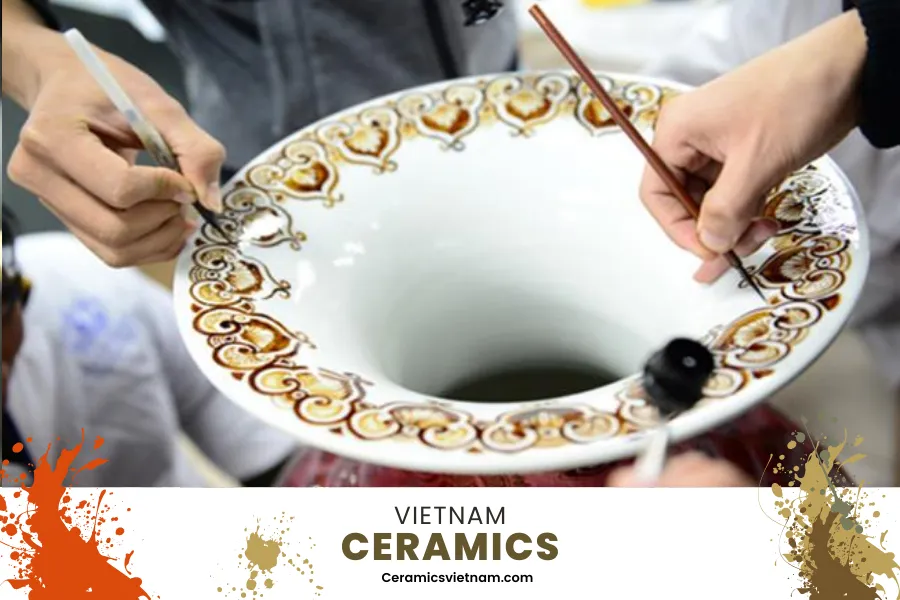
Gold-drawing ceramics
Advantages of Gold-Drawing Ceramics
- Efficient manufacturing process: One of the notable advantages of gold-drawing ceramics is the efficiency of the manufacturing process. When compared to the meticulous gold-inlaid technique, gold-drawing offers a faster production timeline. This means that artisans can create these gilded masterpieces more swiftly.
- Moderate technical requirements: Gold-drawing does not demand an exceptionally high level of technical expertise from the craftsman. While precision and skill are essential, the entry barrier for craftsmen to master this technique is relatively lower compared to other methods.
- Longevity: Gold-drawing ceramics are known for their impressive durability. When properly maintained, these pieces can gracefully adorn spaces for an extended period, boasting a lifespan that can reach an impressive 30-40 years. This durability makes them a wise investment for collectors and enthusiasts.
Drawbacks of Gold-Drawing Ceramics
- Reheating process: While gold is renowned for its resistance to scratching, the gold-drawing process necessitates an additional step. After the initial application of gold, the product must undergo a heating process once more. This step is crucial to ensure the secure adhesion of the gold layer to the ceramic surface.
- Suitable for small products: Gold-drawing ceramics are particularly suited for smaller items. The process is highly effective when applied to diminutive pieces, such as delicate teapots or intricate figurines. However, it may pose challenges when used on larger products.
- Quality matters: The success of gold-drawing ceramics hinges on the quality of the ceramic ingots used. If the base material is not of high quality, it can become fragile when subjected to the second heating process. This fragility may result in product breakage and the loss of the meticulously applied gold layer.
- Emphasis on product borders: Artisans predominantly employ the gold-drawing technique to create borders that accentuate the product’s form and features. While it can be used on smooth surfaces, it shines most brightly when highlighting the edges of the ceramic piece, adding a touch of sophistication and visual intrigue.
On the whole, gold-drawing in ceramics offers a unique blend of efficiency, durability, and artistic expression. It stands as a worthy counterpart to the meticulous art of gold-inlaid ceramics, catering to different artistic preferences and practical considerations. Whether as a border or an intricate detail, the application of gold through drawing adds a layer of timeless beauty to ceramic creations, ensuring that they continue to captivate and inspire for generations to come.
The process of applying 18k and 24k gold on ceramics
The art of embellishing ceramics with the shimmering allure of 18k and 24k gold is a meticulous process that demands precision, patience, and a deep understanding of craftsmanship. This article unveils the step-by-step journey of transforming smooth and pristine ceramic products into gilded masterpieces that captivate the senses.
Step 1: Preparing the canvas
The journey begins with smooth and immaculate ceramic products. These blank canvases serve as the foundation for the gold embellishment process. The ceramics are prepared to be white and clean, ensuring that they provide an ideal surface for the application of precious metals.
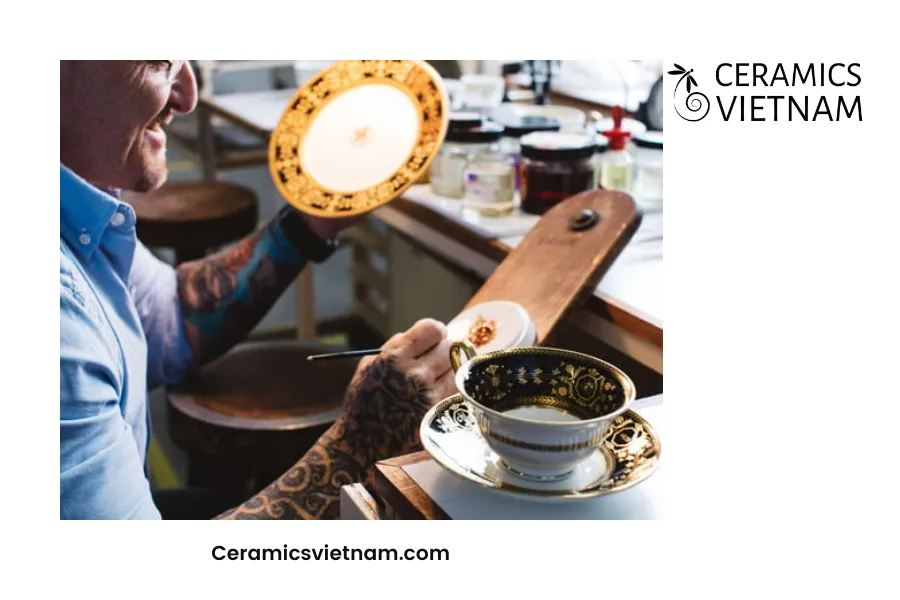
The process of applying 18k and 24k gold on ceramics
Step 2: Applying the base layers
To lay the groundwork for the gold infusion, craftsmen coat the ceramic surface with a smooth enamel and a tacky layer of paint. This adhesive layer plays a crucial role in ensuring the gold adheres seamlessly to the ceramic. After approximately 8 to 10 hours, the glue dries completely, marking the readiness for the next stage.
Step 3: The art of brushwork
With the base layers in place, the craftsman’s skill takes center stage. Using a steady hand and a keen eye, the artisan meticulously follows patterns and lines on the ceramic, delicately drawing the design that will soon gleam with golden brilliance. This step demands a high level of precision and artistry.
Step 4: Patience is key
After the artistic work is complete, patience becomes a virtue. The glue must be allowed to dry entirely, which takes several hours. Applying gold prematurely, while the glue is still wet, is strictly avoided. Doing so would cause the delicate gold leaf to wrinkle and fail to adhere properly to the ceramic surface.
Step 5: Gilding with gold
Once the glue has dried completely, it’s time for the transformational moment. The craftsman carefully applies 18k or 24k gold, covering the ceramic with a lustrous layer of precious metal. The gold leaf adheres to the prepared surface, imbuing the ceramic with its resplendent radiance.
Step 6: The art of cleanup
After the gold has been meticulously placed, a bristle brush is employed to sweep away any excess gold dust. This crucial cleanup step ensures that only the intended areas are adorned with gold. Once the gold has adhered securely, time is required for the dust layer to dry, which typically occurs over the course of the next 30 days.
Step 7: The final touch
To complete the process and preserve the lustrous beauty of the gold-infused ceramic, a glossy coating is applied to the exterior. This protective layer not only enhances the aesthetics but also safeguards the delicate gold layer, ensuring its enduring brilliance.
The process of applying 18k and 24k gold to ceramics is a symphony of craftsmanship, patience, and artistry. Each step is a testament to the dedication of artisans who transform humble ceramics into exquisite pieces of art that radiate with the timeless allure of gold.
Products are made of gold on ceramics
Thien Ma teapot set: A masterpiece of gold-crafted porcelain
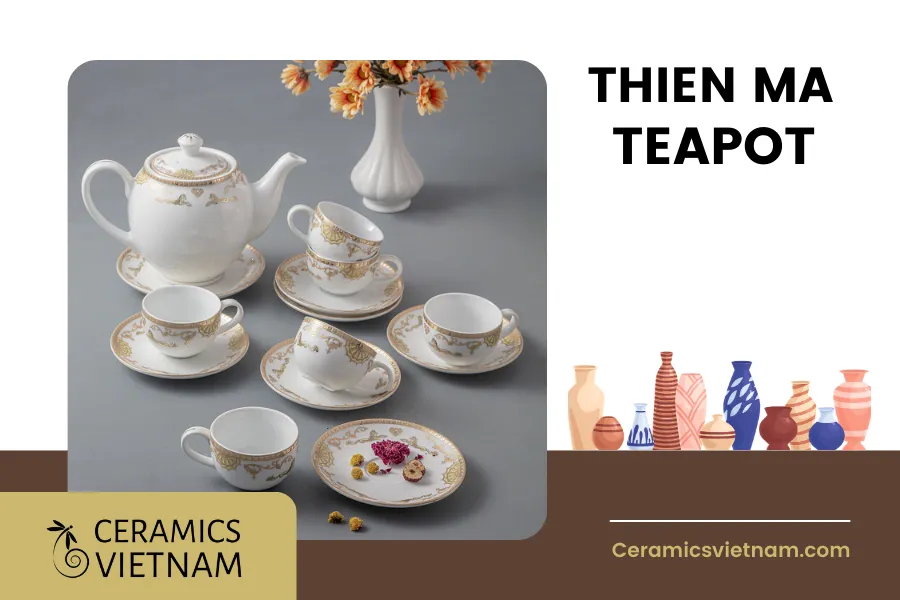
Thien Ma teapot set: A masterpiece of gold-crafted porcelain
The art of crafting gold on porcelain reaches its zenith in the exquisite Thien Ma teapot set. This set, adorned with the captivating motifs of “Thien Ma”, marries tradition and modernity, elevating the allure of porcelain to new heights. Let’s delve into the enchanting world of this teapot set, where the ancient and the contemporary coalesce in harmonious splendor.
The name itself, “Thien Ma,” encapsulates the essence of this remarkable teapot set. “Thien” signifies heaven, while “Ma” represents a horse. These celestial equines are not just any horses; they are embodiments of grace and power, often symbolizing good fortune and auspicious beginnings in various cultures.
What sets the Thien Ma teapot set apart is the intricate craftsmanship that goes into its creation. The two golden horses and the classic patterns adorning the porcelain are not mere embellishments; they are meticulously polished and plated by skilled artisans. This painstaking process requires a blend of tradition, artistry, and a keen eye for detail.
The result is a teapot set that commands attention and admiration. It embodies a luxurious aura that seamlessly merges with a modern aesthetic. The gilded horses gallop across the porcelain with an air of regal grandeur, while the classic patterns harken back to a time when artistry knew no bounds.
What makes the Thien Ma teapot set truly exceptional is its ability to strike a balance between opulence and contemporary design. It is a testament to the enduring appeal of gold-crafted porcelain, a tradition that transcends time and captivates generations.
For connoisseurs and collectors alike, the Thien Ma teapot set is not just a piece of tableware; it is a work of art that embodies the fusion of heritage and innovation. It invites you to sip tea in style, all while basking in the radiance of gold and the timeless allure of porcelain.
Loc Binh: Elevating ceramics with 24k gold
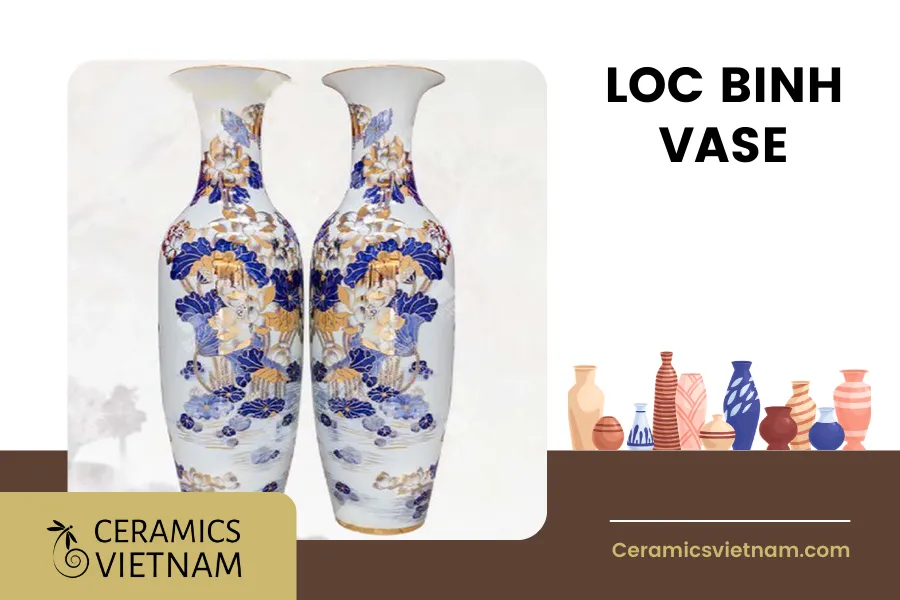
Loc Binh: Elevating ceramics with 24k gold
In the realm of ceramics, there exists a treasure that transcends its material form—the Loc Binh vase. This exquisite piece, adorned with a radiant coat of 24K gold, is more than just a decorative item; it is a vessel of blessings and a symbol of prosperity. Let us explore the artistry and significance of the Loc Binh vase, a harmonious fusion of craftsmanship and feng shui principles.
At the heart of the Loc Binh vase lies the allure of 24K gold, a metal renowned for its luminosity and purity. The glistening gold adorning this vase is not merely ornamental; it carries with it an aura of profound significance, representing blessings and abundance.
In the realm of feng shui, the Loc Binh vase holds a special place. It is considered more than a decorative piece; it is a potent symbol of wealth and prosperity. Placing this vase in your home is believed to usher in blessings that fill the house, creating an environment conducive to prosperity, abundance, and the flourishing of one’s family line.
The Loc Binh vase is more than just a symbol of immediate prosperity; it represents the continuity of blessings through generations. It serves as a testament to the enduring legacy of a family, a timeless vessel that imparts its blessings to each new member who comes into the world.
Beyond its symbolic value, the Loc Binh vase is an embodiment of elegance. The radiant gold, meticulously applied by skilled craftsmen, transforms this vase into a work of art that seamlessly blends tradition and modernity. Its presence in any space elevates the aesthetic and adds a touch of opulence.
For those who appreciate the significance of gold on ceramics and the artistry it entails, the Loc Binh vase is not just a decorative item; it is a cherished treasure. It serves as a reminder of the blessings that surround us, the prosperity that awaits, and the enduring beauty of artistry that transcends time.
The gold-drawing worship set: Weaving gold into the fabric of ceramics
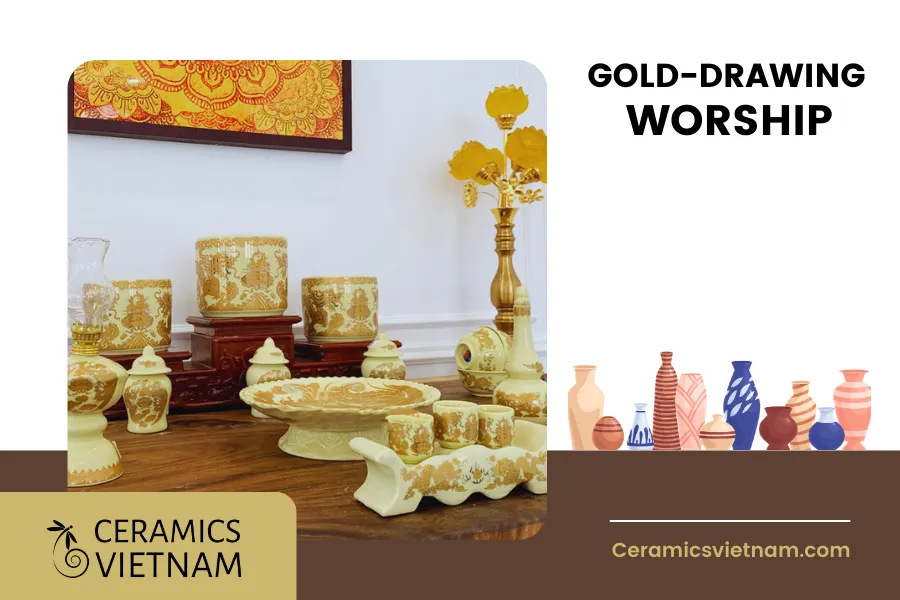
The gold-drawing worship set: Weaving gold into the fabric of ceramics
In the world of ceramics, there exists a treasure that is more than just art—it is a testament to the fusion of craftsmanship and spirituality. The gold-drawing worship set, meticulously crafted with the skilled hands of artisans, epitomizes the art of making gold come alive on ceramics. Let us embark on a journey to discover the elegance, spirituality, and meticulous artistry behind this exceptional worship set.
At the heart of the gold-drawing worship set lies the harmonious marriage of two remarkable techniques: gold-drawing and handcrafted embossed patterns. The artisans who craft this set possess a deep understanding of both the precision required for gold-drawing and the artistry demanded by embossed patterns. Together, these techniques create a visual symphony that resonates with elegance and spirituality.
The creation of the gold-drawing worship set is a labor of love, one that requires the deft touch of skilled craftsmen. Each intricate detail, from the delicate embossed motifs to the precise gold-drawing, bears witness to the artisan’s dedication and expertise. It is a testament to the timeless tradition of handcrafted artistry that breathes life into ceramics.
What sets this worship set apart is not only the skill that goes into its creation but also the quality of materials used. High-quality ceramic materials serve as the canvas upon which the delicate embossed motifs are meticulously inlaid with gold. This union of fine materials and skilled craftsmanship results in a set that exudes luxury, class, and spiritual depth.
The gold-drawing worship set is more than just an art piece; it is a spiritual anchor. When placed in a worship space, it transforms the environment, creating a sacred atmosphere conducive to reflection, devotion, and reverence. Its presence elevates the act of worship, adding a layer of beauty and grace to the spiritual experience.
For those who appreciate the artistry of ceramics and the depth of spirituality, the gold-drawing worship set is a timeless treasure. It embodies the essence of craftsmanship, spirituality, and the enduring beauty of gold on ceramics. It stands as a symbol of devotion, a work of art, and a testament to the artistry that transcends time.
In the pursuit of artistry, the fusion of ceramics and gold has yielded creations that transcend mere aesthetics. The meticulous techniques of gold-inlay, gold-drawing, and gold-gilding have transformed ceramics into treasures that tell stories of tradition, artistry, and spirituality. Each method, with its unique characteristics, speaks to the hearts of collectors, connoisseurs, and those who seek beauty infused with meaning.














Leave a reply